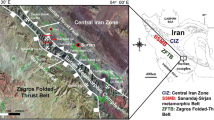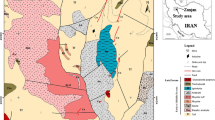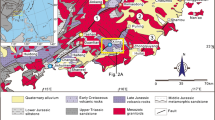Abstract
Sn–W deposit of the Mueilha mine is one of many other Sn–W deposits in the Eastern desert of Egypt that associated with albite granite. Two forms of Sn–W mineralizations are known at the Mueilha Sn-mine area, namely fissure filling quartz veins and greisen. Cassiterite and/or wolframite, sheelite, and beryl are the main ore minerals in the greisen and quartz veins. Subordinate chalcopyrite and supergene malachite and limonite are also observed in the mineralized veins. To constrain the P–T conditions of the Sn–W mineralizations, fluid inclusions trapped in quartz and cassiterite, have been investigated. The following primary fluid inclusion types are observed: CO2-rich, two-phase (L + V) aqueous, and immiscible three-phase (H2O–CO2) inclusions. Low temperature and low salinity secondary inclusions were also detected in the studied samples. Microthermometric results revealed that Sn–W deposition seem to have taken place due to immiscibility at temperature between 260°C and 340°C, and estimated pressure between 1.2 to 2.2 kb. Microthermometric results of fluid inclusions in fluorite from fluorite veins illustrated that fluorite seems to be deposited due to mixing of two fluids at minimum temperature 140°C and 180°C, and estimated minimum pressure at 800 bars.






Similar content being viewed by others
References
Amine MS (1947) A tin-tungsten deposit in Egypt. Econ Geol 42(7):637–671
Bettencourt JS, Leite WB Jr, Goraieb CL, Sparrenberger I, Bello RMS, Payolla BL (2005) Sn-polymetallic greisen-type deposits associated with late-stage rapakivi granites, Barzil: fluid inclusion and stable isotope characteristics. Lithos 80:363–386
Beurlen H, Da Silva MRR, De Castro C (2001) Fluid inclusions microthermometry in Be-Ta-(Li-Sn)- bearing pegmatites from Borborema Province, Northeast Brazil. Chem Geol 173:107–123
Bodnar RJ (1993) Revised equation and table for determining the freezing point depression of H2O–NaCl solutions. Geochim Cosmochim Acta 57:683–684
Brown PE, Lamb WM (1989) P–V–T Properties of Fluids in the System H2O–CO2–NaCl: new graphical presentations and implications for fluid inclusion studies. Geochim Cosmochim Acta 53:1209–1221
Brown PE (1989) FLINCOR: a microcomputer program for the reduction and investigation of fluid inclusion data. Am Mineral 74:1390–1393
Brown PE (1998) Fluid inclusion modeling for hydrothermal system. Rev Econ Geol 10:151–171
Bugrov VA, Abu El-Gadael A, Soliman MM (1973) Rare-metallic albitities as a new type of ore-mineralization in Egypt. Annals of the Geological Survey of Egypt III:185–206
Diamond LW (1992) Stability of CO2 clathrate hydrate + CO2 liquid + CO2 vapour + aqueous KCl-NaCl solutions: experimental determination and application to salinity estimates of fluid inclusions. Geochim Cosmoch Acta 56:273–280
El-Ramly MF, Akaad MK, Al-Far D (1959) Cassiterite- wolframite mineralization near Gabal Mueilha. Geol Surv Egypt Cairo 6:18
El-Ramly MF, Ivanov SS, Kochin GC (1970) Tin-tungsten mineralization in the Eastern Desert of Egypt. In: Moharram O (ed) Studies on some mineral deposits of Egypt. The Egyptian Geological Survey, Cairo, pp 43–52
Fall A, Tattitch B, Bodnar RJ (2011) Combined microthermometric and ramman spectroscopic technique to determine the salinity of H2O-CO2-NaCl fluid inclusions based on clathrate melting. Gechim Cosmochim Acta 75(4):951–964
Haapala I (1997) Magmatic and postmagmatic processes in tin-mineralized granites: topaz-bearing leucogranite in eurajoki rapakivi granite stock, Finland. J Petrol 38(12):1645–1659
Hussein AA (1990) Mineral deposits. In: Said R (ed) The geology of Egypt. Balkema, Rotterdam, pp 511–566
Hussein AA (1973) Results of the mineral; exploration program in Southeastern Desert of Egypt. Ann Geol Surv Egypt III:109–124
Jackson NJ, Willis-Richards J, Manning DAC, Sams M (1989) Evolution of the Cornubian orefield, S.W. England. Part II: Mineral deposits and ore-forming processes. Econ Geol 84:1101–1133
Kelly WC, Turneaure FS (1970) Mineralogy, paragenesis and geothermometry of the tin and tungsten deposits of the Eastern Andes. Bolivia Econ Geol 65:609–680
Krumrei T, Kaliwoda M, Pernicka E, Markl G (2007) Volatiles in a peralkaline system: abiogenic hydrocarbons and F–Cl–Br systematic in the naujaite of the Ilimaussaq intrusion, South Greenland. Lithos 95:298–314
Linnen RL (1998) Depth of emplacement, fluid provenance and metallogeny in granite terranes: a comparison of western Thailand with other tin belts. Mineral Dep 33:461–476
Lockwood Geophysical Survey Corporation (1968) Airborne magnetometer, scintillation counter, dual frequency and electromagnetometer survey for a part of Aswan region. Contractor's report for the UNITED Nations, Toronto, p 140
Mohamed MA (2010) Geochemistry and fluid evolution of the peralkaline rare-metal granite, Gabal Gharib, Eastern Desert of Egypt. Arab J Geosci. doi:10.1007/s12517-010-0244-9
Mohamed MA, Bishara WW (1998) Fluid inclusions study of Sn-W mineralization at Igla area central Eastern Desert, Egypt. Geol Soc Egypt Cairo 42/1:207–220
Mullis J (1979) The system methane-water as a geologic thermometer and barometer from external part of the Central Alps. Bull Mineral 102:526–536
Neiva AMR (2008) Geochemistry of cassiterite and wolframite from tin and tungsten quartz veins in Portugal. Ore geology reviews 33:221–238
Ramboz C, Pichavant MA, Weisbrod A (1982) Fluid immiscibility in natural processes: Use and misuse of fluid inclusion data: II. Interpretation of fluid inclusion data in terms of immiscibility. In: Kreulen R, Touret J (eds.) Current research of fluid inclusions. Chem Geol 37:29–48
Roedder E (1984) Fluid inclusions. In: Ribbe PH (ed) Reviews in mineralogy, vol 12. Mineralogical Society of America, Washington, p 644
Roedder E (1992) Fluid inclusions evidence for immiscibility in magmatic differentiation. Geochim Cosmochim Acta 56:5–20
Roedder E, Bodnar RJ (1980) Geologic pressures determination from fluid inclusion studies. Annu Rev Earth Planet Sci 8:263–301
Sabet AH, Chabanenco V, Tsogev V (1973) Tin-tungsten and rare metal mineralization in the Central Eastern Desert of Egypt. Ann Geol Surv Egypt 6:53–73
Sabet AH, Tsogoev VB, Spiridonov VP, Sarin LP, Abdel-Nabi (1976) Geologic structure and laws of localization of tin-beryllium mineralization at the Igla deposit. Ann Geol Surv Egypt VI:157–168
Schönenberger J, Markel G (2008) The magmatic and fluid evolution of the Motzfeldt intrusion in South Greenland: Insights into the formation of agpaitic and miaskitic rocks. J Petrol 10(9):1549–1577
Shepherd TJ, Miller MF, Scrivener RC, Darbyshire DFP (1985a) Hydrothermal fluid evolution in relation to mineralization in southwest England with special reference to the dartmoorbodmin area. High heat production (HHP) granites, hydrothermal circulation and ore genesis. The Institution of Mining and Metallorgy, London, pp 345–364
Shepherd TJ, Rankin AH, Alderton DHM (1985b) Apractical guide to fluid inclusion studies. Blackie, London, p 239
Soliman MM (1984) Ore element distribution in the Mueilha tin mine area, Southeastern Desert, Egypt. J Univ Kuwat (Sci) 11:97–112
Touret J, Dietvorst P (1983) Fluid inclusions in high grade anatectic metamorphism. J Geol Soc Lond 140:635–649
United Nations (1973) Assessment of the mineral potential of the Aswan region. Technical report. Follow-up geophysical survey (1968–1972) for the Government of the ARE (Egypt). DP SF UN 114, New York, p 90
Wilkinson JJ (2001) Fluid inclusions in hydrothermal ore deposits. Lithos 55:229–272
Zhang YG, Frantz JD (1987) Determination of the homogenizationtemperature and densities of supercritical fluids in the system NaCl–KCl–CaCl2–H2O using synthetic fluid inclusions. Chem Geol 64:335–350
Author information
Authors and Affiliations
Corresponding author
Rights and permissions
About this article
Cite this article
Mohamed, M.AM. Evolution of mineralizing fluids of cassiterite–wolframite and fluorite deposits from Mueilha tin mine area, Eastern Desert of Egypt, evidence from fluid inclusion. Arab J Geosci 6, 775–782 (2013). https://doi.org/10.1007/s12517-011-0402-8
Received:
Accepted:
Published:
Issue Date:
DOI: https://doi.org/10.1007/s12517-011-0402-8




